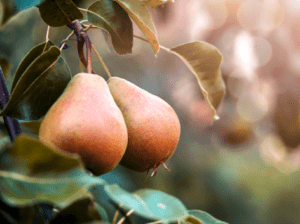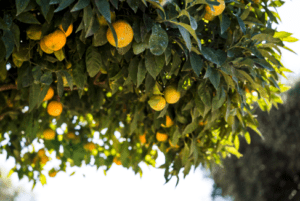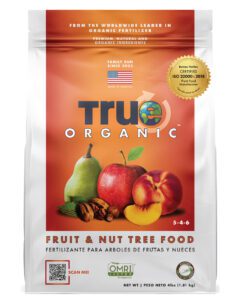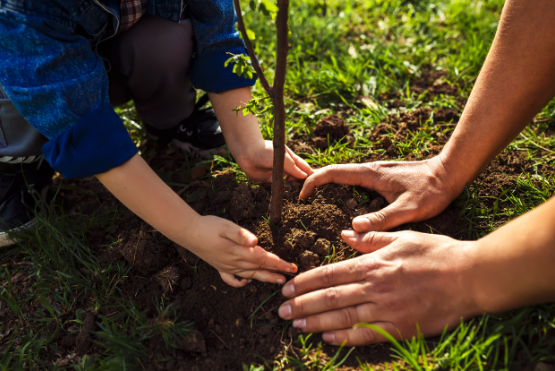Jan 31, 2023
8 Best Fruit Trees for Your Home Garden
8 Best Fruit Trees for Your Home Garden
Do you dream of relaxing in a dreamy orchard buzzing with bees and birds? Enjoying ripe fruit and relaxing under blossom-filled trees?
We created our Fruit & Nut Tree Food, the latest addition to the True Organic plant food family, to make your backyard orchard dreams come true!
Even if you only have room for one or two fruit trees, you can definitely grow delicious fruit in your home garden (or even indoors). With some forethought and research, even a small outdoor space can accommodate fruit trees.
How to choose?
Here’s what to consider before you commit to a fruit tree for your home garden:
Size & Space
How much space do you have for your tree(s)? Fruit trees range greatly in size and some can even be cultivated successfully in containers. Some dwarf fruit trees might grow to just 6-8 feet tall and 2 feet wide!
Choose types that will be easy to find room for as they grow and bear fruit.
Plant Hardiness Zone
Choose a type of fruit tree that thrives in your climate. Thankfully, there are fruit trees that love almost every Zone, even in cold and dry climates.
Soil Type
Is the earth in your yard sandy, acidic, loamy? Different varieties of fruit trees thrive in specific types of soil, so find out what kind of soil you’re working with before you buy any trees. Check out our blog with Agronomist Dr. Margaret McCoy, PhD for all the details on soil testing.
Pollination Requirements
Some trees are self-pollinating (like most of your garden crops) but some require cross-pollination. Non-self-pollinating trees won’t produce a good harvest without a “partner tree” to pollinate them.
If you choose a tree that needs to be cross-pollinated, you’ll either need to make sure there is another tree of the same species nearby (within 100 feet is ideal for bees) or you’ll need to hand-pollinate (which is much simpler than you might think, but still requires a bit of expertise and time). The pollination partner needn’t be the same variety of fruit, just the same species.
Learn more about pollination requirements for various crops with these helpful resources from Penn State University’s College of Agriculture Extension.
Your Favorite Fruits
As with any garden crop, grow what you love! While it can be fun to experiment with new crops and varieties, the most rewarding part of growing fruit trees is eating delicious, nutritious, sweet treats. So go with your favorites.
New to growing fruit trees? Try one of these:
Pear

Like many fruit trees, pears need to grow for a few years before fruiting. Pear trees typically start bearing fruit after 3 years, but some take at least 7 years before they’ll give you fruit.
Because of their natural disease resistance, pear trees are ideal for growing organically. Like most fruit and nut trees, they’ll do well when fertilized twice a year: once in the spring and once in the fall. Use an organic fertilizer like our Fruit & Nut Tree Food, which is rich in nutrients like phosphorus, calcium, sulfur, and nitrogen.
Many varieties of pear tree are self-pollinating, too!
Apple
The classic apple tree is a home gardening favorite for good reason! Apple trees are generally easy to grow, high-producing, and hardy in lots of climates. One of the best trees for beginners, apples do require several years before they start bearing fruit — for some varieties, up to 8 years.
But like some other types of fruit trees, some apple varieties are “dwarf” trees that grow around 10-15 feet tall and can start fruiting after only 2-3 years.
Apples are non-self-pollinating (also known as “self-unfruitful”), so one lonely apple tree in the backyard might not yield fruit on its own. Plant another apple tree nearby or scope out your neighborhood to see if any neighbors are growing apples.
Fig
Figs are such a fun, underrated fruit and they’re shockingly simple to grow!
Fig trees thrive in many climates and can be kept in small spaces. Like pear trees, fig trees are very resistant to disease, are typically self-pollinating, and grow quickly — you don’t need to wait years for a fig tree to bear fruit.
Cherry

Most cherry trees start yielding fruit on their fourth year, so be ready to commit before you start putting cherry pie on the menu.
Birds love cherries, so be prepared to cover your trees after the flowering stage.
Plum
There are a surprising number of varieties of plum, so there’s sure to be one that fits your needs and your tastes. Depending on the variety, plum trees may be self-fertile or cross-pollinating, so be sure to commit to a type of plum tree you can care for properly.
Watch out for soil that doesn’t drain well when you’re growing plum trees, as they can be particularly sensitive to waterlogged soil.
Apricot
Juicy, sunset-colored apricots are a bit easier to grow than peaches and yield a whole lot of fruit. Best of all, they bloom early, so you’ll be eating apricots first thing in the springtime.
These delightful trees are self-pollinating and grow big branches full of luscious green leaves, perfect for lounging beneath.
Because of their early blooming nature, though, watch out for late frosts and cold snaps, which could damage flowering apricot trees.
Lemon

Lemon trees are great for container growing and can even be grown indoors with the right care. Indoor container lemon trees will stay under 4 feet tall. So cute!
They can grow happily in various kinds of soil (although they prefer slightly acidic soil) and are easy to care for. Most varieties will start bearing fruit in their third or fourth year.
Lemon trees are very cold-sensitive and cannot withstand frost, so be prepared to cover your lemon tree if you live in a place that gets frost.
Crabapple
Okay, not many people want to grow crabapple, but hear us out! Crabapple trees may not produce the yummiest fruit, but they are stunning additions to any landscape with their sweet-smelling blossoms of white, pink, and pale red.
Crabapple trees grow in a ton of different climates, and while they don’t like hot weather, some varieties can thrive in extreme cold, even in Zone 2a (Alaska!)
So what about that fruit? Crabapples (which technically just means an apple that is tiny — under 2 inches in diameter, to be exact) are super-tart and hard in texture. They’re not good to eat raw (unless you’re a bird or a squirrel), but you can make delicious jams, jellies, fruit butters, even crumble and crisps.
If you’re new to fruit trees or live in a cold climate, crabapples are a great place to start learning how to plant and care for these wonderful garden additions.
Show us your True Organic Plants
#GrowWithTrue
www.trueorganic.earth




